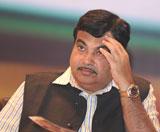
Bhopal, November 5: Hoping to stave off another controversy, BJP chief Nitin Gadkari Monday denied he had compared the intelligence quotient (IQ) level of Swami Vivekananda to that of fugitive don Dawood Ibrahim.
Cornered by reporters ovee his speech in Bhopal, Gadkari said: "I did not make any comparison between Swami Vivekananda and Dawood Ibrahim... I said if one used one's intelligence properly then one could become a Vivekananda, and vice versa."
"I am being misquoted," the Bharatiya Janata Party chief said.
In a speech at an award function in Bhopal Sunday evening, Gadkari said: "In psychology, we measure the IQ level of people... But it depends from person to person, in what area they choose to use their intelligence."
"If we could compare the IQ level of Swami Vivekananda and that of Dawood Ibrahim, then it could have been almost similar. But their direction in life is so different. While Vivekananda used it for nation building, brotherhood and spiritualism, Dawood used it for destructive purpose, to excel in the crime world," Gadkari said at the Ojaswini felicitation programme to honour leading women in various fields.
BJP leader Balbir Punj Monday denied that Gadkari had likened the spiritual leader with Dawood.
"He did not liken Vivekananda to Dawood, he only brought out the contrast," said Punj.
Punj tried to explain the comment by saying that the party chief "was only stating a fact" that any kind of power, money or intellect, can be used to purse good or evil things.
Congress leader Digvijay Singh tweeted Monday: "In a function in Bhopal Gadkari said "IQ of Swami Vivekanand and Dawood Ibrahim was same" Any comment from Modi and his fans ?"
Gadkari has been under attack from anti-corruption activists for alleged financial impropriety in business dealings in connection with his Purti Group. Gadkari has denied all charges and the party has backed him.





Comments
Add new comment